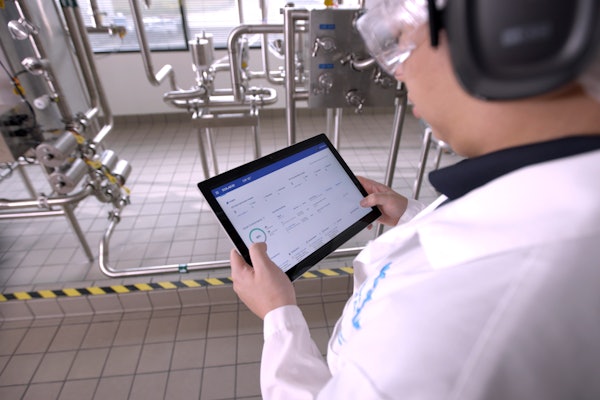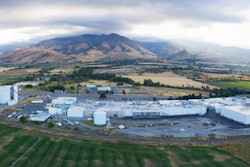Quick hits:
- Consumers are demanding more in the way of ingredients, selection, sizes, and sustainable packaging, but manufacturers are facing challenges due to supply chain issues and labor shortages.
- Automation is the biggest investment trend, but other equipment upgrades may be necessary to meet sustainable material needs.
- E-commerce and D2C are other trends forcing change in the market.
- The food and beverage industry is shifting to adopt more AI applications.
- AI improves operational efficiency, food quality and safety, sustainability, and supply chain challenges.
- An iterative approach to AI adoption is the most efficient method of application.
Related to this episode:
- Proper AI Application Fuels Food and Beverage Innovation
- Beverage Manufacturers Respond to Consumer Trends on Plastic Packaging
- Ready-to-Drink Functional Beverages the Latest Growth Market
- Increase in Online Grocery Shopping Impacts Beverage Pack Sizes and Machine Needs
 | Read the transcript below: |
Kim Overstreet: Hi, I’m Kim Overstreet, and today I’m going to talk about beverage trends and a report from PMMI Business Intelligence.
Almost all beverage manufacturers interviewed for the report are experiencing shortages sourcing materials and ingredients, and to keep up with consumer demand, they need to add greater efficiency to their operation by making machines “smarter” and updating older equipment with modern technology.
Many said they are planning to add additional packaging equipment to their operations, as well as processing machinery, filling equipment, and new sterilization systems.
Automation is the biggest investment trend, with 72% of manufacturers intending to expand data-driven solutions in their operations. They would also like to increase the amount of data they are collecting and analyzing, by using sensor deployment and increased integration.
There are a few consumer-driven trends affecting the beverage market, and the first is functional ingredients. Consumers are turning to beverages as a way to incorporate functional ingredients into their diets, hoping to regulate mood, improve mental fitness, and promote physical performance.
Nootropics, pre, pro and post-biotics are all growing in popularity, and to incorporate these into beverages, manufacturers are introducing new ingredients and new offerings into their portfolios.
83% of manufacturers interviewed are altering ingredients to meet consumer health demands and are consequently turning to clean and clear labeling to promote these changes. 33% are looking into smart packaging [RFID, NFC, and QR codes], and augmented reality labeling has grown in beverage packaging 120% in two years’ time.
Sustainability and e-commerce are two of the other trends affecting the beverage market.
89% of beverage manufacturers are trying to make their products more sustainable by reducing the amount of plastic in packaging, necessitating machinery that can run at a variety of speeds and handle a variety of recycled content.
And finally, as the pandemic accelerated online grocery sales, 61% of consumers said they shop online now more than they did pre-pandemic, and it’s predicted that market share gains will remain at least partially beyond the pandemic.
D2C sales have also become more common, with 44% of beverage manufacturers interviewed shipping some of their products directly to consumers through e-commerce orders.
Related e-commerce consumer preferences for products like gallon size, multipacks, and smaller sizes are likely to continue as well.
Thanks for watching. If you’d like to download this free report, check out this link.
Melissa Griffen: Hi, I’m Melissa Griffen, Contributing Editor for ProFood World. The food and beverage industry is witnessing a shift to adopt more artificial intelligence applications to improve and address issues of operational efficiency, food quality and safety, sustainability, and supply chain challenges.
A Globe Newswire article quotes research by Facts & Factors, projecting an annual CAGR growth of 45.70% for the Global Artificial Intelligence in Food and Beverages Market from 2021 to 2026. Companies need to know how to successfully apply AI to their facilities in order to take advantage of its benefits and expected growth.
In a recent webinar, Demonstrating the Power of AI for Food and Beverage Innovation, Sridhar Sudarsan, chief technology officer at SparkCognition—a provider of AI systems for the industrial space, including manufacturing—outlined 4 steps to successfully apply AI applications, which are: data availability, leveraging data, usability of insights, and scaling infrastructure. Sudarsan states that an iterative approach of taking these steps as a single unit, in bite-sized chunks is the most efficient method of application.
He further explains that most companies have the means to start at their fingertips with unused data from a myriad of sources, such as machines, logs, image data from cameras, and even worker tribal knowledge. The key is gathering the right data sets, as available data is not necessarily actionable data. Once it is collected, all that information must generate insights that operators and managers can then take action on, which requires building and using an AI or other model. You want that AI model to integrate into the systems the company already has so the insights can reach the right person or system at the right time. You further want to apply insights across company locations and products.
For more on how to successfully apply these steps, check out the full story. Thanks and see you next time on Take Five with ProFood World.





















